Saturn's Rings
Saturn’s rings have posed a big challenge ever since Galileo first laid eyes on them in 1610 through his 20-power telescope. He interpreted his first observation as a spherical planet with two smaller spheres beside it, two years later he no longer saw the smaller spheres, and still later he reported seeing parts of several ellipses (see drawings). He had no way of knowing that he was seeing a thin tilted ring system that can appear quite different from one year to the next as the relative position of Earth and Saturn changes.

Sketches of Galileo’s early observations of Saturn’s rings; first he concluded there was a moon on each side of the planet later he saw half-ellipses.
Huygens in 1625 proposed a thin, flat, solid ring—a rigid disk—which did explain the periodic disappearance of the ring, when Earth lies in its plane and the ring is seen edge-on. In 1675, Cassini observed a gap in the ring system, which is now called the Cassini Division, and he correctly hypothesized that the rings are composed of small particles. This particle model gained support in 1849, when Roche determined the distance, called the Roche limit, at which a satellite held together by gravity would be broken apart by tidal forces.
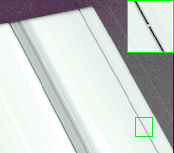
This Voyager image shows the tiny moon Pan, only 20 km in diameter, barely visible after considerable image enhancement (Mark Showalter and the PDS-Rings Node)
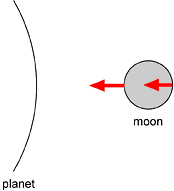
Gravitational forces on the near and far side of a moon, as shown by the two red arrows. The difference in these two forces can rip a moon apart if it is too close to a planet.
Tidal forces originate in the inverse square dependence of the gravitational force on distance. As shown in the diagram, Saturn pulls more on the nearer part of a satellite and less on the more distant part, resulting in a force that tends to rip the moon apart if it is close enough to the planet. For satellites of Saturn, the Roche limit is about 2.4 times the planet’s radius, as measured from the center of the planet, which places nearly all of the ring system within this limit. Solid objects can exist within the Roche limit, since they are held together by more than gravity—by atomic and molecular forces—but moons inside the limit must be small, and indeed the four Saturnian moons within the ring system have radii ranging from 10 km to 50 km, with the smaller of these closer to the planet’s surface.
Also, from Kepler’s Laws, a satellite’s period squared goes as the radius cubed, so the ring particles closer to the planet have shorter periods than those further out, ruling out a solid ring. This differential rotation was first observed in 1895.
Observation of Saturn made a great leap in 1980-1981, when the Voyager 1 and 2 flybys provided a wealth of new data, including incredibly detailed images that delighted both scientists and the public alike. All this new information led to a much better understanding of the details of the ring system, including the explanation of how small “shepherd” moons form some of the narrow gaps. The image, from Voyager, shows the tiny moon Pan, just 20 km across, which produced the gap where it is found.
Research
Twenty years passed before the arrival of the next probe to Saturn, Cassini-Huygens, the result of a collaboration among seventeen nations and three space agencies. NASA’s Jet Propulsion Lab built the orbiter, the European Space Agency put together the Huygens probe, and the Italian Space Agency contributed Cassini’s main antenna.
After a seven-year trip, including “slingshot” loops around Earth, Venus, and Jupiter, Cassini-Huygens reached Saturn on June 30, 2004. A 96-minute engine burn (see drawing) lowered its speed enough for it to settle into a closed orbit. During this burn, Cassini achieved its closest approach to the surface, 18,000 km (11,000 mi), or about one-sixth the planet’s diameter—much closer than Voyager’s 41,000 km (26,000 mi) —and Cassini made the most of its vantage point by capturing 61 detailed images of the ring system. Compare the detail of the Voyager and Cassini images showing wave-like ripples in the A-ring, which is the outermost wide ring.
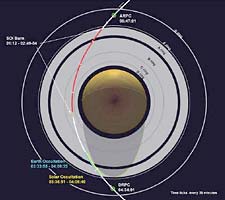
Path of Cassini spacecraft during the engine burn (shown in red) that placed it in a closed orbit around Saturn; the burn was the closest approach of all orbits in the four-year mission, so Cassini took advantage of this opportunity to produce highly detailed images of the ring system. (image courtesy of NASA)
In a different observation, a spectrometer on board Cassini analyzed visible and infrared light transmitted through the rings. One surprising result was the presence in the ring system of “dirt,” like that observed on Saturn’s moon Phoebe, which suggests that the rings are the remnants of a disintegrated moon. Supporting this theory is the fact that the total mass of the ring system is about the same as that of an average-sized Saturn moon, which raises the possibility that a former moon wandered in too close to the planet and disintegrated. The rings, made of boulder-sized chunks of ice, contain relatively little “dirt,” less than previously believed, with the “dirt” concentrated in the ring gaps. The image shows the region around the A ring in ultraviolet light, with ice in blue and dirt in red.
The ultraviolet spectrometer on board Cassini produced perhaps the biggest surprise so far, a huge burst of oxygen in the E ring, with about four times the mass of the ring itself. Since presumably the oxygen comes from the decomposition on the ice in the ring—there’s not much other stuff around—the source of so much oxygen is quite a mystery. Scientists speculate that big hitherto-undiscovered ice chunks may have collided and released the oxygen, but E ring particles seen so far are very small.
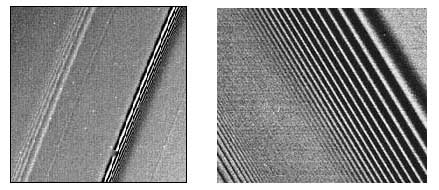
This pair of images, the one on the left from Voyager and the one on the right from Cassini, show the structure of Saturn’s A ring. Note the detail in the Cassini image. The moon Mimas, and its shadow, are visible in the Voyager image. (image on the left courtesy of Mark Showalter and the PDS Rings Node; image on the right courtesy of Cassini Imaging Team, SSI, JPL, ESA, and NASA)
More excitement is yet to come. In January, 2005, the Huygens probe will be parachuted onto Titan, whose atmosphere contains organic compounds. Huygens will take data all the way down and after landing, radioing its results to Cassini for transmission to Earth. Check your newspaper, and Physics Central too, for updates.
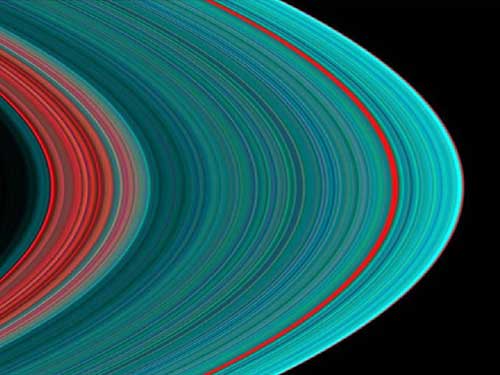
Images of the region around Saturn’s A ring. Blue indicates ice, and red indicates “dirt,” similar to the material on the moon Phoebe. The dirt is concentrated in the gaps—how this has happened is a mystery. (image courtesy of UVIS, University of Colorado, ESA, and NASA)
Links
NASA
University of Colorado
Space Science Institute
European Space Agency
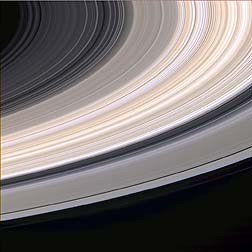
The large gap is the Cassini Division.
(Image courtesy of NASA)














